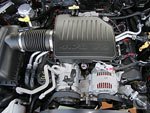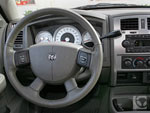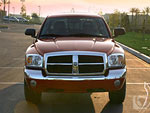 Dodge's Dakota has always followed a pretty simple strategy: stay one step ahead of everyone else in all quantifiable areas. Ranger, Tacoma, and S-10 too compact? Make Dakota taller, wider, and a foot longer. Everyone stuck with weak 4-and 6-cylinder engines that can barely pull a U-Haul? Start with a V6 and offer a step-up V8 that can haul ass. Not enough room? Give Dakota four full doors, then watch a whole new segment spring up around it from everyone else's mimicking.
Dodge's Dakota has always followed a pretty simple strategy: stay one step ahead of everyone else in all quantifiable areas. Ranger, Tacoma, and S-10 too compact? Make Dakota taller, wider, and a foot longer. Everyone stuck with weak 4-and 6-cylinder engines that can barely pull a U-Haul? Start with a V6 and offer a step-up V8 that can haul ass. Not enough room? Give Dakota four full doors, then watch a whole new segment spring up around it from everyone else's mimicking.To Dodge's dismay, the mimicking has gone on for a while now. Nearly everyone has been matching the Dakota's targets, especially lately and especially the Japanese. After all, adding capacity and capaciousness is hardly a secret formula.
Dodge can't get away with this one-upmanship forever - there's something called the Ram serving as the upwardly mobile glass ceiling - but with the new Dakota of 2005, they're pulling it off one last time. So after eight straight years of living with the last version, it's time to say hello to the biggest, most capable Dakota yet, and possibly ever.
Road Test

Hemi no esta aqui. Sorry, but the cure-all, smoke-everyone engine that seems to invigorate the speed and sales of every Chrysler product it finds itself into just wouldn't fit in the Dakota without some complicated modifications.
Yet engines still comprise the front page headline in the Dakota newsroom. The last-generation Dakota inherited its motors from the one before it, but instead of another decade with the gasping-for-air 120-horsepower AMC 4-cylinder or the not-much-better 175-horsepower 3.9-liter Magnum V6, we now have the Jeep Liberty's 3.7-liter V6 raising the standard to a more reasonable 210 horsepower and 235 pounds-feet of torque. And following a move made by the Grand Cherokee, the Dakota also threw out the old 5.2 and 5.9-liter overhead valve V8s for a 4.7-liter overhead cammer that's stronger than the former and smoother than both. (All changes took place at various points over the past few years.)
Expectations of the segment's only V8 weren't completely fulfilled. The last Dakota used to wow everyone by pulling off 8.8-second 0-60 runs, but this isn't 1997 anymore. At present, 230 horsepower - not much for 4.7 liters to begin with - just doesn't cut it when the new Tacoma and Frontier are pulling 236 and 265 out of their V6s. That and the Dakota's range-topping 4,751-pound curb weight make it no surprise that initially strong acceleration turns leisurely once you get going, with at least one downshift and a deep dive into the slow-responding gas pedal needed for any good pass - a common case among engines with a ton of torque but a pittance of power. Adding a second camshaft or squeezing more than two valves in each cylinder could really raise the potential here.
At least the engine sounds good when it's being thrashed and has a partner that's deft at handling its output. We've met this transmission before in the Grand Cherokee, Ram, and Durango alike: Chrysler's 5-45RFE five-speed automatic with two second gears - the second one for more mild passing needs - which at least partly explains its seamless shifting habits (though on downshifts, it insists on passing through the higher second gear to get to the lower one, delaying acceleration somewhat). The Dakota's handling ain't half bad either, with enough feel and speed in its new rack-and-pinion steering to keep it maneuverable on a mild mountain road. If it doesn't dance with the Frontier's spirit, it does have the Tacoma's competency.
Since truck hardware is so configurable, take note that our Dakota had 2006's new TRX Off-Road Group, which throws in BFGoodrich LT 265/70R16 All-Terrain tires and "special" shocks. (It also deletes the rear stabilizer bar; the Dakota is unique in offering one.) On dry roads, they let the Dakota perform on par with the low end of passenger cars, losing grip fairly early but never embarrassing itself. The only reservation is how hitting the brakes in a fairly high-g turn sends the rear swinging wide, which gets a bit freaky with no stability control to catch you. And for an off-road package, shouldn't there be some kind of hill-descent control system, and shouldn't ground clearance be closer to 10 inches than 7.9?
But few Dakotas will ever leave the pavement, and Dodge's knowledge of this shows in the Dakota's suspension tuning. Some have praised it for its "refined ride quality." Surely enough, the Dakota deals with ruts and cracks like a Lexus even while using the standard pickup truck suspension: front control arms paired with a leaf-sprung live axle. Pretty great for a truck. But you eventually run across some higher-amplitude bumps (even a speedbump will suffice) and soon notice that the Dakota starts heaving and bounding like the Titanic in a tsunami. There are a few ways to achieve a soft ride. Assembling a suspension from Mr. Slinky springs and Buick Roadmaster shocks is certainly one of them.
A more indisputably favorable point in the Dakota's on-road resume is Dodge's inclusion of full-time 4-wheel-drive (more commonly called all-wheel-drive) into one of its two optional 4WD systems. Its center differential sends 48% of the power forward by default and redirects when necessary; it's no wonder the Dakota accelerates through curves with no tailspin and generally feels planted. Ford, GM, Toyota, and Nissan all truck on by with their less-flexible part-time systems or rear-wheel-drive.
The brakes feel decent for a setup with drums in the rear, with only a little self-energizing stickiness in the pedal action, near the bottom. The Dakota's wide 44-foot turning circle and occasional need for five-point turns (caused by its relatively elongated length and wheelbase) are the last points to mention in what's generally a fine-driving truck.
Inside & Out

Here's the full story on those lengths and wheelbases. As with the most recent Ram, Dodge ditched the Dakota's unpopular no-cab body styles, leaving only the Club Cab (extended cab) and Quad Cab (crew cab) models, both measuring exactly 218.8 inches long, 82.1 across, 68.7 high, and 131.3 between the wheels. Ranger, Colorado, Frontier, and Tacoma span 198, 207, 206, and 208/221 long, so aside from that last one (a Double Cab Long Bed Tacoma), the Dakota stands pretty far above. Since Dodge follows the common plan of a 6-foot-long box with the small cab and a 5-foot box with the big cab, all the Dakota's extra size should go straight to passengers.
Hmm, guess not: adult males sitting in front the way they prefer usually squeeze adult males in the back. The EPA measurements show the Dakota having the best legroom, but our government didn't bother to measure space for feet under the impossibly low-mounted power driver's seat (room under the passenger's is slightly better), and that makes all the difference. The middle passenger also gets some foot space stolen by the cupholders near his soles, and a chunk of his seat cushion was chipped off. The Dakota's rear quarters are on level with the best crew cabs', but as with the engine, the obvious advantage promised by the numbers didn't quite happen.
Front riders have no such issues with their roomy and comfortable surroundings. The controls were designed sensibly: clear instruments, easily-reached center stack controls, cruise controls on the steering wheel's face and audio controls on its backside, right by your fingertips. There are too many of those buttons to easily memorize, but the rest was fine. The relationship between seat, pedals, and steering wheel is good enough to make a telescoping steering wheel unnecessary, though the front seats don't fold back far enough for a pitstop nap. The cupholders could be designed better, but at least there are three of them, along with two power outlets. Side/side curtain air bags aren't standard like on some other trucks, but at least the passenger's knows when to turn itself off. Also, the Dakota's see-through rear head restraints make Dodge the first to realize the importance of being able to see other cars on the road.
The Dakota doesn't score quite as well when it comes to subjective quality. The silver-painted plastic does a poor job posing as aluminum, the drab colors don't help (including the bland cyan glow from the instruments at night), and the dash and instruments are generally unappealing and uninspired. Finally, after feeling the seats, I was shocked that Dodge would dish out a press car lined with crude vinyl, then shocked once more upon looking at the window sticker and discovering it really was leather. The compartments also close a bit cheaply, and having one or two more wouldn't hurt.
But it's a fine place for audiophiles. One past week spent with another new-in-2005 Chrysler truck, the Grand Cherokee, built up expectations of a lame listening experience, but the Dakota's 6-disc MP3 CD changer (with Sirius satellite radio) proved to be a quantum leap forward in sound quality. The Jeep's unit is just a bunch of misguided watts; the Dakota is about power with focus and clarity. The Laramie model's Alpine speakers make all the difference, and the optional auxiliary jack for portable audio devices count for a lot.
Nothing remarkable about the Dakota's bed. Just your average big, empty, pre-lined rectangular box - 64.9" by 59.6" by 17.6" (for 39 cubic feet total) - with an easy-to-lift tailgate. You can store extra stuff in the cabin by flipping up the back seats in one simple step.
Other Thoughts

The Dakota has more of that choose-your-own-adventure thing going than do the other mid-size trucks. Its drive systems, engines, transmissions, and trim lines combine in the following ways:
1. 2WD V6 manual - ST / SLT
2. 2WD V6 automatic - ST / SLT / Laramie
3. 2WD V8 manual - ST / SLT / Laramie
4. 2WD V8 automatic - ST / SLT / Laramie
5. 2WD High Output V8 automatic - SLT / Laramie
6. 4WD V6 manual - ST / SLT
7. 4WD V6 automatic - ST / SLT / Laramie
8. 4WD V8 manual - ST / SLT / Laramie
9. 4WD V8 automatic - ST / SLT / Laramie
10. 4WD High Output V8 automatic - SLT / Laramie
All combinations can be had in either the Club Cab or Quad Cab body, and in sum, you can do nearly anything except order a stickshift with the high-output V8 or the Laramie trim line. The base prices on those range from $19,435 to $31,925. To name a few key prices, the V6's 4-speed automatic costs $1,095, the V8 engine costs $785, the high-output V8, $1,615, and the 5-speed automatic used by both, $1,170. The cost of 4WD runs the gamut among the trim lines, but the upgrade from that to full-time 4WD runs $395 on the SLT and Laramie. Jumping from Club Cab to Quad takes $1,400-$1,490 except in the case of #1, where it's $2,700.
The differences between trim lines aren't too vast, with the SLT adding a bright grille, body-color front bumper and rear chrome bumper, aluminum wheels, fog lights, upgraded instrument cluster, power windows/locks/mirrors, keyless entry, folding center armrest and console (on Quad Cab). The Laramie throws in the horrible leather seats, automatic headlights, auto-dimming mirror, 6-disc MP3 CD changer with Sirius satellite radio, and steering wheel audio controls.
Going by performance, it takes the Dakota's high-output V8 to compare with the Frontier and Tacoma (from which you can expect fuel economy even more dismal than our 14 MPG - on premium gas - and even less cruising range than our 265 miles). If you take a 2WD V8 SLT Dakota and throw in a bedliner, sliding rear window, antilock brakes, side air bags, the 6-disc MP3 CD changer, and Alpine speakers, you're looking at a $28,880 Dakota. (Ours was decked out past 34.) Checking off as many equivalent boxes as possible under the Nissan Frontier 2WD Crew Cab rings up a tab of $26,930.
As car as the editorial eye can see, what the Dakota can do that others can't comes down to towing: the Dakota's capacity chart reveals an impressive 7,150 pounds in its best version. Both the Frontier and Tacoma are stuck at 6,500 pounds, with Ford's aging Ranger down at 6,000 and Chevy's 5-cylinder weakling capping out at 4,000 pounds. Heck, the Dakota can tow a Colorado and a Ranger behind its back - a rather appropriate image considering that with this Dakota, Chrysler just defeated its domestic competition.
But spending two extra grand over that Frontier, I'm not so sure. That Nissan is more fun to drive, asks for less fuel and gives more power, is almost as comfortable to sit in, and has an interior that's as cool as the Dakota's is lame, so unless the extra 650 pounds of towing are a make-or-break difference (to be fair, it is a big difference), you're really hauling around all that extra annoying mass for nothing. Nissan really raised the midsize truck bar last year, and it takes more than extra size and cylinders to clear it. [source : automotive.com]
Post a Comment